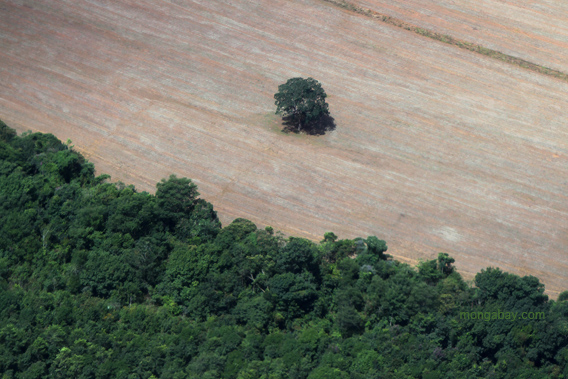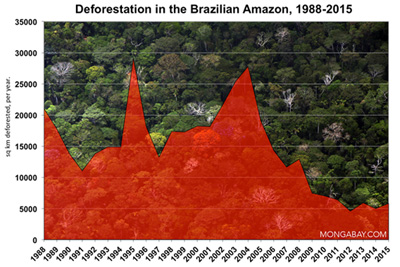
Deforestation and forest degradation are down moderately from August through October 2011 relative to the same period a year ago, reports a satellite-based assessment released today by Imazon, a Brazilian group.
Imazon’s near-real time system, which tracks change in forest plots 25 hectares (62 acres) or larger, found that 512 square kilometers of rainforest were cleared between August 2011 and October 2011, the first three months of the deforestation calendar year, which runs from August 1 through July 31 to coincide with the dry season when it is easiest to measure forest cover. The figure represents a 4 percent decline from the 533 square kilometers cleared in 2010.
Imazon’s system also tracks forest degradation — including logging and fire damage — that often precedes outright deforestation. It recorded a 52 percent decline in degradation from 2,599 sq km to 1,246 sq km.
Overall Imazon estimated that deforestation and degradation in the Brazilian Amazon during the period committed 32 million tons of carbon dioxide to the atmosphere.
Satellite monitoring
The short-term systems used by Imazon and Brazil’s National Space Research Agency INPE, which has its own platform, are less accurate than the systems used for tracking annual change in forest cover. These rapid systems are used mostly to identify deforestation hotspots so authorities, provided they have funds and political backing, to take immediate action to stop illegal clearing. The annual systems can identify areas of clearing down to 6.25 hectares (15.6 acres).
Critics of these deforestation tracking systems — which are generally considered the best and most transparent national systems in the world — complain that ranchers and farmers, wise to the limitations of satellite monitoring, have adapted their clearing practices to evade detection. As such, they contend that deforestation rates may be higher than reported. But researchers are working on more precise monitoring capabilities that would better reflect realities on the ground.
Trends in Amazon deforestation
 |
Deforestation in the Brazilian Amazon has slowed significantly since last peaking in 2004. The Brazilian government says enforcement efforts, combined with conservation initiatives and sustainable development programs, have contributed to the decline, but analysts contend that macroeconomic trends, including a strong real, which reduces profits for Brazilian commodity producers, play a bigger role. Research published in 2010 attributed 37 percent of the drop in deforestation between 2002 and 2009 in the Brazilian Amazon to new protected areas.
The decline in deforestation rates in other Amazon countries has not kept pace with Brazil. For example, Peru has seen a sharp jump in deforestation since 2005 due to the paving of the Transoceanic highway, which has spurred conversion for cattle ranches and large-scale agriculture, mining, and logging. Guyana’s deforestation rate more than tripled last year.
Commodity production — including cattle, soybeans, minerals, and timber — is the biggest direct driver of deforestation in the Amazon. Industries seeking to expand production are now exerting considerable political pressure to relax environmental laws. In Brazil, the agroindustrial lobby is pushing hard for an overhaul of the country’s Forest Code, which limits the amount of forest landowners are permitted to clear. The proposed revision — which the Senate is expected to vote on next week — would grant amnesty for past illegal deforestation (up until mid-2008), while reducing requirements for legal forest reserves and setbacks along waterways. Green groups fear the changes could spur an immediate increase in deforestation.
But another threat looms large over Earth’s biggest rainforest: climate change. Scientists have repeatedly warned that higher temperatures in the tropical Atlantic will trigger rainfall shifts that leave much of the Amazon drier and more vulnerable to drought. And there are already signs these warnings should be heeded: in the past five years the Amazon experienced the two worst droughts ever recorded. Researchers say that deforestation and forest degradation will worsen the impacts of climate change by disrupting the hydrological functions of the forest.
Related articles